Students, staff share issues with campus elevators.



LSUReveille.com

Students, staff share issues with campus elevators.



LSUReveille.com
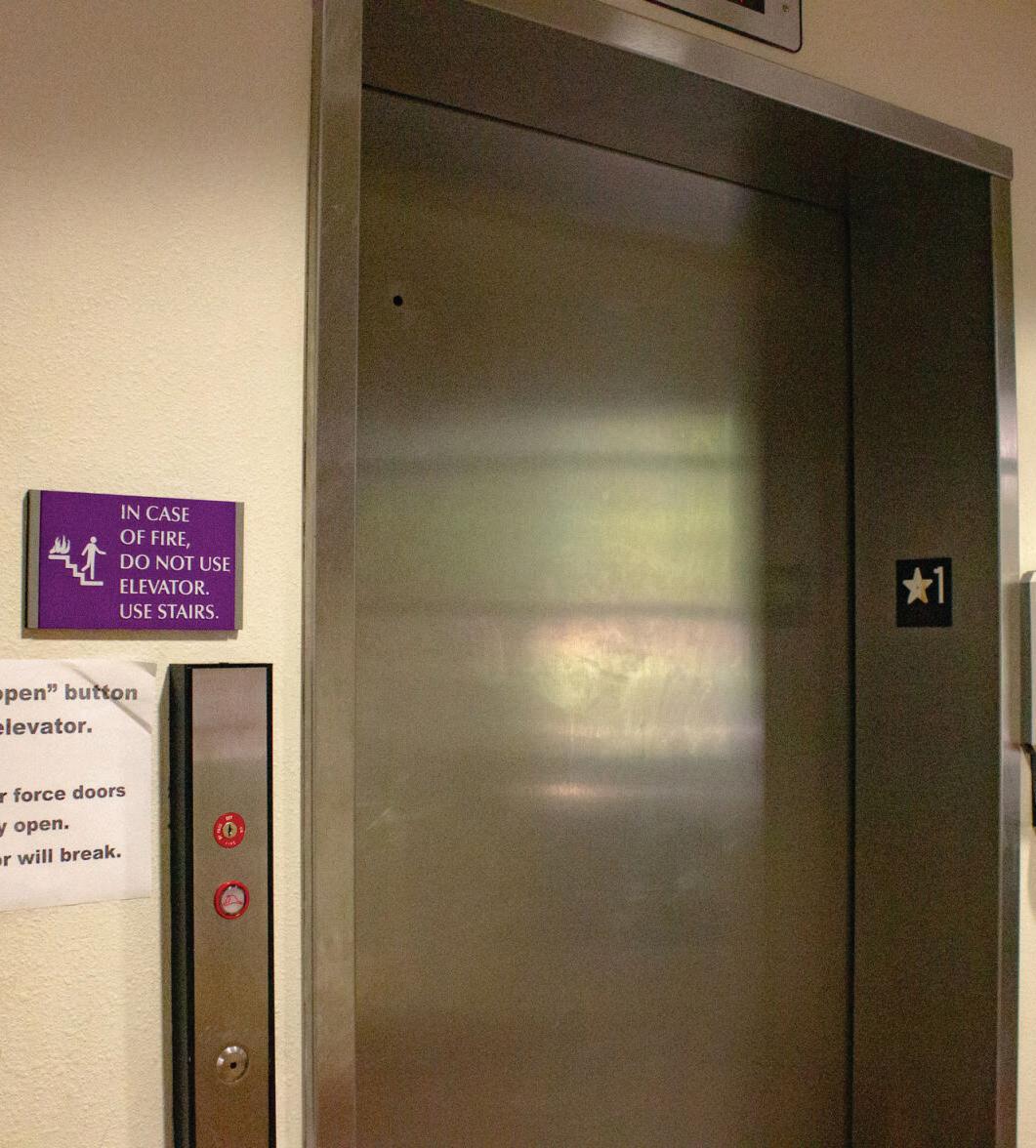 BY DOMENIC PURDY & SIERRA VANDERHORST @tigerdom16 & @sierravand
BY DOMENIC PURDY & SIERRA VANDERHORST @tigerdom16 & @sierravand
Nicholson Gateway resident Ashanti Stokes was on her way to the second floor printing room when the elevator passed her des tination and hit the very bottom on what was supposed to be a quick trip to Canal Hall’s printing room.
The next thing Stokes, a mass communication senior, and her friend knew, they were stuck on the first floor with no way out, hearing the unmistakable thud of a broken elevator. They immediately hit the call button.
Instead of connecting to LSUPD, LSU Transit answered the call. When the worker picked up, Stokes asked if she could be connected to the police but was told it was not possible. The worker, with no way to help, hung up.
Stokes and her friend were now stuck in an elevator with no phone service and no connection to local authorities.
“We just [started] banging on the door for the elevator, waiting for someone,” Stokes said. “We knew eventually someone would have to come by.”
After being trapped for about 20 minutes in the hot elevator, she said that help finally came in the form of a student worker who heard their cries and called the po lice.

“They eventually come and they start on it, trying to break us out,” Stokes said. “That takes like 10 [to] 15 minutes.”
Stokes is not the first student to get caught in an elevator on cam pus. Many have passed taped-off elevators, haphazard out of order signs or had the unfortunate expe rience of being trapped themselves.
According to interim associate director of Facility Maintenance Brian Broussard, there are three workers on campus who are con tracted through Stratos, the current elevator contractor for LSU.
The contracted workers on cam pus will often be called because of spilled food caught in the door and elevators being held open for an extended period. Both of these require a reset on the elevator to get it running again, and can be resolved within an hour. But other elevator complications are not as simple as an on-the-spot fix.
“[An] elevator is like a car. There are a million parts,” Brous sard said. “There [are] mechanical components, there is hardware, there [are] even software compo nents.”
Some areas on campus, like the Life Sciences Building, have older elevators, which can result in more maintenance calls, Brous sard said. In this case, the elevator is analyzed and reported through a third party elevator consultant. The consultants then communicate the steps needed to upgrade and fix the elevator.
According to Broussard, the Life Sciences elevator has been put on the deferred maintenance list that will be addressed when funds are available.
According to executive director of Facility and Property Oversight Tammy Millican, “all elevators that were tested this summer passed inspection and any code issues on the inspection reports have been addressed,” adding that the eleva tors around campus are serviced and inspected annually by the State Fire Marshal.
Despite Facility Services’ main tenance of the elevators on cam pus, sometimes repairs and service slips through the cracks. This was the case for the elevator in Pat rick F. Taylor Hall’s annex, which has been out of service for a pro longed period of time, said Chris Schwehm, the College of Engineer ing’s director of IT.
“It was fine for the longest time,” Schwehm said. “Probably some where between six to nine months ago it just stopped working.”
Two trouble tickets were filed through FAMIS, the maintenance management system used by LSU Facility Services, on Oct. 28, 2021, requesting service for the sole el evator in the annex, which was in stalled during the second phase of Patrick F. Taylor Hall’s construction in 2017.
The tickets, which complained that the elevator couldn’t access past the second floor, were marked as complete on Nov. 11, 2021, and Jan. 26, 2022, respectively.
Faculty members had previous ly filed complaints about the eleva tor, Schwehm said.
Another ticket was filed on Nov. 9, 2021, complaining that “the el evator does not open, and it does not come when it’s called.” This ticket was marked as complete on Feb. 7, 2022.
According to Schwehm, the is sue persisted even after the tickets were marked as complete.
“We’ve had tickets in; they’ve never fixed it,” Schwehm said. “It just kind of sat there. Everytime we inquire about it, it just gets post poned and we never get a real an swer about what the problem was.”
According to Schwehm, since there is only one elevator in the an nex, many professors and students have to cross the entire building to get to a working elevator to access the annex’s second and third floor classrooms.
“I think it does create issues for some people, and I also think there are people that may have ADA is sues you don’t obviously recognize to the untrained eye,” Schwehm said. “You really don’t know how many people it’s affecting; it could be a lot more than we are aware of.”
Despite Schwehm and other fac ulty in Patrick F. Taylor Hall taking issue with Facility Services’ mainte nance of the elevator, other prob lems are solved more expediently.
Schwehm said that when it comes to issues with the HVAC system or anything dealing with water, “they get over there really quick and do what they need to do to alleviate the problem.”
“I just don’t understand why we can’t get it fixed,” Schwehm said. “[But] I’ve been elsewhere on cam pus where things have been much worse.”
According to Millican, the building that receives the most calls concerning its elevators is the Student Union, with its six eleva tors receiving 27 calls this year as of Oct. 5. Other buildings that re ceive frequent elevator calls are the LSU Law Center, the LSU Library and Herget Hall.
“In many cases, the number of elevator repair calls Facility Servic es received is impacted by the age of the building, number of stories and level of usage,” Millican said. “Therefore, you will see more calls for buildings such as the Library, residential life facilities and Life Sciences.”
Despite elevators being fre quently serviced and having access to Facility Services’ maintenance, campus’ issue with elevators ex tends beyond disrepair. In multiple locations on campus, students and faculty don’t have access to any elevators, much less a functioning one.
National resource ecology and history junior Pascale Delahous saye fractured her ankle and had surgery in August. She said it was particularly tricky to navigate campus, especially having to use crutches to get to her third floor unit at East Campus Apartments with handfuls of groceries.
“It’s definitely a hassle going up and down those stairs everyday,” Delahoussaye said. “I lack stamina at the end of the day. A 10-minute walk for me is like a 20-minute od yssey.”
East Campus Apartments and West Campus Apartments, as well as other buildings like Himes Hall, don’t have elevator access, forc ing Delahoussaye and others with more permanent mobility disabili ties to adapt to a lack of elevators around campus in specific areas.
“The lack of elevators on cam pus, it comes as a shock that there aren’t elevators in these buildings,” she said.
According to Millican, the uni versity’s ADA code requires new ac ademic buildings to have elevators, but because many of the univer sity’s older buildings, like Himes, were built prior to ADA codes and haven’t been brought up to code. East Campus Apartments and oth er apartments are not required to have elevators, Millican said.
With the exception of Himes and her apartment, Delahoussaye said that campus is extremely ac cessible with her boot and crutch es, praising the Energy, Coast and Environment Building’s elevators.
She also said that she had to figure out Himes and East Campus Apartments’ lack of accessibility the hard way, encountering Himes’ steep descent to the testing center.
“It is LSU’s duty towards their students that they have the acces sibility,” Delahoussaye said. “Be cause it does definitely impact the quality of your education, if ev eryday, you have to organize your classes around which building [you] can enter.”
B-16 Hodges Hall Louisiana State University Baton Rouge, La. 70803
NEWSROOM (225) 578-4811
Editor-in-Chief JOSH ARCHOTE


Digital Managing Editor
HANNAH MICHEL HANKS
Digital Editor
JAYDEN NGUYEN News Editor BELLA DARDANO
Deputy News Editor
DOMENIC PURDY
Sports Editor
PETER RAUTERKUS
Deputy Sports Editor MACKAY SUIRE
Entertainment Editor
AVA BORSKEY
Opinion Editor CLAIRE SULLIVAN
Multimedia Editor
MATTHEW PERSCHALL
Production Editor
MADISON COOPER
Chief Designer
EMMA DUHE
(225) 578-6090
Layout/Ad Design EMILY TRAN
Layout/Ad Design SOFIA RAMOS
Correction: In an article printed in the Nov. 21 edition, it was reported that Jeff Landry ran for governor in 2019. Landry did not run in the 2019 gubernatorial race.
The Reveille is written, edited and produced solely by students of Louisiana State University. The Reveille is an independent entity of the Office of Student Media within the Manship School of Mass Communication. A single issue of The Reveille is free from multiple sites on campus and about 25 sites off campus. To obtain additional copies, please visit the Office of Student Media in B-39 Hodges Hall or email studentmedia@ lsu.edu. The Reveille is published biweekly during the fall, spring and summer semesters, except during holidays and final exams. The Reveille is funded through LSU students’ payments of the Student Media fee.
The LSU Social Research and Evaluation Center is partnering with the East Baton Rouge Par ish School System and Dreambox Learning to tackle disparities in mathematical knowledge within Baton Rouge schools, according to East Baton Rouge Parish School spokesperson, Benjamin Lemoine.
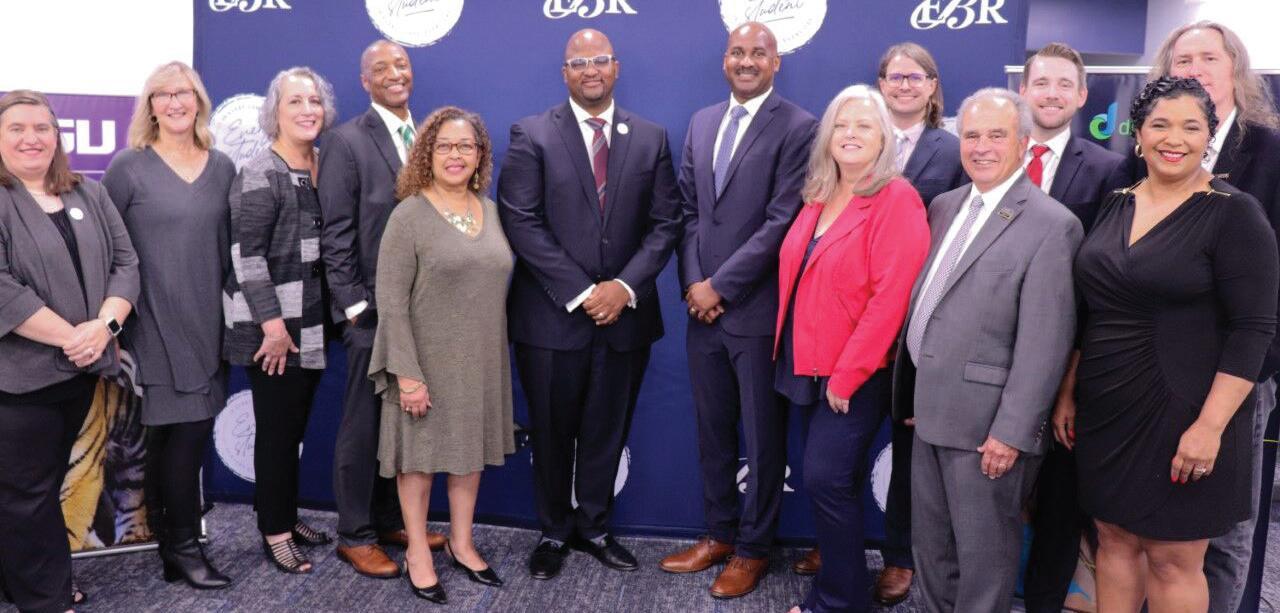
Lemoine said that district lead ers applied for the Bill and Melin da Gates Foundation Math Equity Grant through an opportunity of fered by the Council of Great City Schools.
“This is the first time [the] East Baton Rouge Parish School System has applied for a Gates Foundation grant,” Lemoine said. “The district is always researching grant oppor tunities and applying for those that are an appropriate fit.”
According to an East Baton Rouge Parish School System press release, the Bill and Melinda Gates Foundation awarded the East Ba ton Rouge Parish School System a $3.5 million “Research and De velopment Partnerships for Math Equity” grant for economically dis advantaged and minority students.
East Baton Rouge Parish School System will be part of a 33-month innovative pilot program that will combine existing, collaborative research partners to develop new customized intervention models, data-tracking and teacher training for online student learning, the
ACADEMICS
press release read.
The press release also said the project’s agenda intends to devel op new technical research tools to create an upward trajectory in stu dents’ math learning and provide local public access to successful data studies across the U.S.
Lemoine said that the grant funding and resources will provide the tools to research and analyze instruction methods and students’ math progress in an effort to iden tify best practices and student en gagement.
“The mission of the East Baton Rouge Parish School System is to inspire humanity through transfor
mational learning in the classroom and in the community and this grant directly meets these goals,” Lemoine said.
Lemoine said that currently, over 80% of district students are classified as economically disad vantaged, while 89% are consid ered a minority.
“Strong foundations in math ematics are essential elements to producing a modern workforce and enabling our students to not only be prepared for college and career readiness but also to thrive as adults,” Lemoine said.
Dreambox is an online software program that East Baton Rouge
Parish students currently utilize for mathematical learning interven tions, according to Lemoine.
The online resources allow for personalized and differentiated math instruction for all elementary and middle school students.
The East Baton Rouge Par ish School System chose the LSU Social Research and Evaluation Center to be a research partner, according to Judith Rhodes, direc tor of the LSU Social Research and Evaluation Center.
Rhodes said that the Bill and Melinda Gates grant requires a school system, a technology solu tions partner and a research part
ner to conjointly implement the grant. She said that LSU Social Re search and Evaluation Center has previously partnered with East Baton Rouge Parish School Dis trict, and they both applied for the grant.
Rhodes said that LSU Social Re search and Evaluation is research ing the role of technology through Dreambox Learning to increase math skills in K-12 grades.
Rhodes said that there has been a learning loss due to children learning at home or hybrid since the COVID-19 pandemic. She said that Dreambox Learning’s gamified platform allows children to learn math materials and promote ac celerated math as the levels within the app increase.
East Baton Rouge Parish School Board Vice President Dawn Collins said the research through the part nership brings clarity into the basis of learning.
“By conducting research in stead of making assumptions, it’s a real opportunity to address per ceived achievement gaps within education,” Collins said.
Furthermore, she said it’s im perative to address the learning needs of students in poverty.
“Education is ‘The Great Equal izer’ and in a place like Louisiana with some of the lowest wage rates in the nation, and therefore highest poverty rates particularly among people of color, it’s imperative we raise the tides in math excellence to lift all boats,” Collins said.
LSU offers two programs for students interested in pursuing film: the screen arts program housed in the College of Hu manities and Social Sciences, and the film and television program housed in the College of Music and Dramatic Arts.
According to screenwriting professor Jason Buch, the screen arts program provides a broader view of film, providing students with three tracks to focus on de pending on what their aspirations in the film industry are. He said that of the three tracks—pro duction, screenwriting and film theory—production is the most popular.
Regardless of the track cho sen, Buch said students still take classes related to the other tracks. He said that even if a student is only interested in becoming a screenwriter, for instance, it’s still important to understand produc tion.
“Our goal is that the students get a broad view of what encom passes screen arts and film,” Buch said. “We certainly do everything we can to create production op portunities for students.”
As a result of screen arts’ mul tidisciplinary focus, Buch said that most students in the pro gram will have the opportunity to make several short films.
There’s no one central film school at LSU, so classes are spread out around campus, Buch said. He said this is because many different disciplines can relate to a film education, such as digital art, theatre and mass communica tions.
Buch said there’s advantages and disadvantages to film stud ies not having its own dedicated department, rather split across two programs and several depart ments.
According to Buch, one of the advantages is that screen arts has the opportunity to pull from a wide variety of faculty from vari ous different disciplines to sup
port the program, instead of just being confined to one depart ment.
Kalling Heck, a screen arts professor primarily teaching in the film theory track, said that the screen arts program tries to tie together both production and film theory.
He said students interested in going into academia as film pro fessors and researchers benefit from the production side of the program, as well as students who are only interested in production benefiting from an understanding of film theory.
“I think thinking about and understanding movies in histori cal, theoretical, and conceptual terms is extremely important for thinking about what it is you want to make,” Heck said.
While the screen arts program offers production alongside the other tracks, screen arts senior Ben Caplan said there’s very little focus on production in the pro gram. He said that there’s not a whole lot of opportunities to col
laborate with other students to make films.
Caplan said that film not hav ing its own department is a big drawback for the program. He said it makes the program unfo cused.
“I think everyone just has a different idea of what they want and they need someone to really guide it to this real, focused film school,” said Caplan.
Heck said in his experience, a major drawback to film not hav ing its own department is that fac ulty from other departments who want to teach in the screen arts program can’t because of commit ments to their own department, whereas if film had its own de partment the faculty would be completely committed to film.
Although, he said that this disadvantage is outweighed by being able to pull a variety of fac ulty from all over campus.
Connor McLaughlin, an LSU alumnus who graduated with a screen arts degree, said that, with some distance, he sees the screen
arts program excelling at giving students a general understanding of film as a whole.
“It gives you a lot of great tools to excel at the pre-produc tion level of working in the film industry,” said McLaughlin, who is currently studying film at the University of New Orleans’ gradu ate school.
McLaughlin said screen arts excels when focusing on screen writing and theory, adding that they offer a wide array of inter esting classes related to film the ory. He said that the faculty in the program are excellent and very passionate about film making.
Although he appreciated his time with the program, McLaugh lin said there weren’t as many op portunities to make films he felt he could submit to a job. He said that one reason for this was that COVID-19 limited opportunities for students to learn production.
Screen arts junior Rajan Aw asthi said screen arts has a lot of
FILM, from page 3
analytical classes related to film, such as film theory and film his tory. He said the amount of pro duction opportunities students have depends on the classes they take.
“I feel like it would be more fun and helpful if every class had at least one project,” Awasthi said. “That would help reinforce the things that you learn.”

Virtual production professor James Jamerson said the College of Music and Dramatic Arts’ film and television program places more of an emphasis on produc tion, adding that it teaches stu dents how to produce, act in and distribute films.
Still, Jamerson said that the two programs do a lot of col laborating, specifically in the XR studio, a virtual production stage funded through a $1.25 million grant to LSU.
“I think what’s coming down the road is more collaboration, more interweaving of these de partments in really positive ways to create new, better things,” Ja merson said.
Jamerson said students that study in the film and television program will have the opportuni ty to make dozens of short films. He also said they also get to par ticipate in a Geaux Film, where students apply to make a collab orative film. He said the student
whose pitch gets chosen gets to direct the film, adding that the other students still participate in the production of the film.
“Having a funded film, that is your film, isn’t found anywhere else, so I think that it’s some

thing that really makes LSU’s film program stand out,” Jamer son said.
Jamerson also said students are able to check out film equip ment from the department at no cost, provided that they know
how to use the equipment.
Despite the program’s focus on production, Jamerson said that the curriculum doesn’t pro vide students with many classes on screenwriting or film theory, unlike the screen arts program
that has tracks specifically for these fields.
Film and television junior Ma teo Fernandez said the film and television degree is still relatively new. Before the degree students would major in theatre with a concentration in film.

Hoping to focus more on the other tracks offered by screen arts, Fernandez said he would ideally like to see both film pro grams merge together.
“There’s a lot of classes in screen arts that we don’t usually see in our [Bachelor of Fine Arts] so merging those two would be like the ultimate goal,” Fernan dez said.

One thing missing from both programs is a focus on how to break into the film industry, Aw asthi said. Teachers may give advice on how to break in, but beyond that he said there isn’t a lot of focus on it, adding that he would like to see more classes about the film industry from the business side of things.

Despite this, Awasthi said that because his program is smaller, many of his classes feel more tight knit, adding that screen arts majors tend to share similar in terests.

“There’s a sense of commu nity that comes in any class, any screen arts class, eventually, I think sooner rather than later you become good friends with everybody,” Awasthi said.

At FranU we are dedicated to helping you find your vocation through your intellectual, social and spiritual development. Learn about our three schools, 20+ programs, service-learning and more at franu.edu/experience.
5414 Brittany Drive, Baton Rouge, LA 70808 | (225) 526-1700 | franu.edu
Want to see your event in The Reveille? Email information to editor@lsu.edu.

Enjoy some live music before the craziness of finals sets in. This event starts at 7:30 p.m. It will take place at the Manship Theatre, which is located at 100 Lafayette St. Ticket prices range from $30-$45 plus taxes and fees. If you miss the performance on Tuesday, there’s another performance at the same time on Wednesday, Nov. 30.

All students are welcome to help decorate the Student Union for the holidays. There are plenty of activities for a whole friend group to enjoy, such as ornament and cookie decorating and games. This event will take place from 11 a.m. to 2 p.m. in the Student Union lobby. DECEMBER

Baton Rouge band Hotel Burgundy is playing Chelsea’s Live, 1010 Nicholson Drive. The show starts at 9 p.m. on Saturday, Dec. 3, with Quarx and Wonderkid also performing. Tickets are $10 in advance or $15 at the door.
Country, emo, “Fruit Salad” by The Wiggles? It doesn’t matter –Neon Luck can do it all.
Neon Luck is a Baton Rouge cover band that plays songs of all genres and changes the setlist and genre for each show they perform.
Its main members, Chris tian Butler, Nick Ashton, Grant Holmes and Brandon Gallego, met in high school, but they didn’t start playing music togeth er until April of this year.
Butler, the group’s vocalist, is the newest member of the band. Before Neon Luck, he had never been in a band. Now, he’s the stage-strutting, energetic front man for the group.
“After one audition with Chris tian, I knew that he could bring the personality and the vibe that we were looking for,” Ashton, the band’s drummer, said.
Holmes, Gallego and Ashton are former members of a band called Dave Fishingtrip, which split earlier this spring into two new bands: doggish and Neon Luck.
“Half of the band wanted to do original music and half of the band really wanted to lean into the college bar cover thing,” said Holmes, who doubles as front man for doggish and bassist for Neon Luck.
True to their mission, Neon Luck played their first gig at Tiger TV’s Battle of the Bands event at Fred’s and never looked back.
Neon Luck’s name certainly describes the band’s energy on stage.
The personalities of each band member come out when they per form. Butler dances around stage and plays the microphone cord like a guitar. At times, Gallego gets on Holmes’ shoulders while playing a song. Ashton bangs his head and banters with the other members in between songs.
The band’s chemistry and fa miliarity also translates on stage, as each member communicates with one another by the raise of
an eyebrow or nod of the head.
“It’s nonverbals,” Ashton said. “It’s just a testament to the qual ity of these guys and how profes sional and talented they are.”
The band credits most of their professionalism and success to their manager, Lyric Mandell.
Mandell befriended Ashton when she was a TA for one of his class es and, despite having no musi cal background, decided to take on the role of band manager for Neon Luck.
“We would not be where we are without Lyric,” Ashton said. “She took a group of guys who were steadily gigging around and getting once a month type things to just hitting the pavement.”
The band refers to Mandell as their “secret sauce” and credit her as the reason the band went from performing for the first time to releasing its own live album, “Live at Chelsea’s,” in the span of

6 months.
“We were just playing a show at Chelsea’s and somebody brought up the idea that you could track and record the entire thing,” Butler said. “And we were like ‘yeah, why not?’ If it turns out good, then we could use it for something.”
Though the band started with covers, they plan to venture into original music next.
“We’re hoping to record and release a single by the end of the year,” Butler said.
The single is an original song Neon Luck created in order to qualify for Battle of the Bands. It was inspired by Ashton and Butler’s long distance relation ships and is “more hard-seated in rock,” according to Butler.
Neon Luck has had other original songs in the works for a while, but the genre-bending band continues to rework them.
“That’s the hard part with be ing in a cover band for so long. You can compare the final prod uct of what you’re playing to a record,” Ashton said, “but when it’s your own music you’re just so much more picky and you’re never happy with it.”
When it comes to choosing what songs to cover, Neon Luck is all about catering to the crowd.
“We’re pretty much always editing our setlist and adding in new stuff to make this weird salad of everything we’re good at, but also what people want to listen to,” Butler said.
Neon Luck’s setlist can include country classics like “Chicken Fried,” pop such as “Good 4 U,” or rock songs such as “Smells Like Teen Spirit.”
“What we’re trying to do right now is to play as many venues as possible in as many styles as pos sible,” Ashton said.
The band’s main priority is to make sure the songs they play resonate with the crowd. They aren’t too picky about what they play, so long as people enjoy it.
“I love the excitement in peo ple’s eyes when you make a con nection with them, whether it be them on stage or me with a tem porary tattoo,” Mandell said.
Beyond impacting crowds around Baton Rouge, Neon Luck has also changed the members’ lives.
“It’s pretty neat how well we’ve been able to foster the relationships within our band,” Butler said. “I was friends with Brandon. I knew Nick, but we weren’t super close anymore. I didn’t know Grant at all – and now, it feels like a second family, honestly.”
Like any family, or any band, the members have moments where they disagree or argue, but each believes their ability to handle the band’s issues is a tes tament to their closeness.
The band’s biggest struggle? Debating whether or not it should perform a childhood classic.
“We are in constant warfare over playing ‘Fruit Salad’ by The Wiggles,” Ashton said.
When it comes to the future of Neon Luck, the four member group is only focused on continu ing to make crowds happy, re gardless of how big those crowds are.
The most important thing to the band is maintaining the re lationships and comradery they have built with each other.
“If we make it really big, like we’re doing national tours and headlining places, but we don’t have the same energy and dy namic we have now,” Ashton said, “I don’t think I could say I achieved my goals at that point.”
When it comes to putting on a show, Neon Luck will try any thing once– music venues, bars, sorority events– even playing 50th birthday parties.
“If you want to have a good time and your mom wants to have a good time,” Butler said, “you need to hire Neon Luck.”
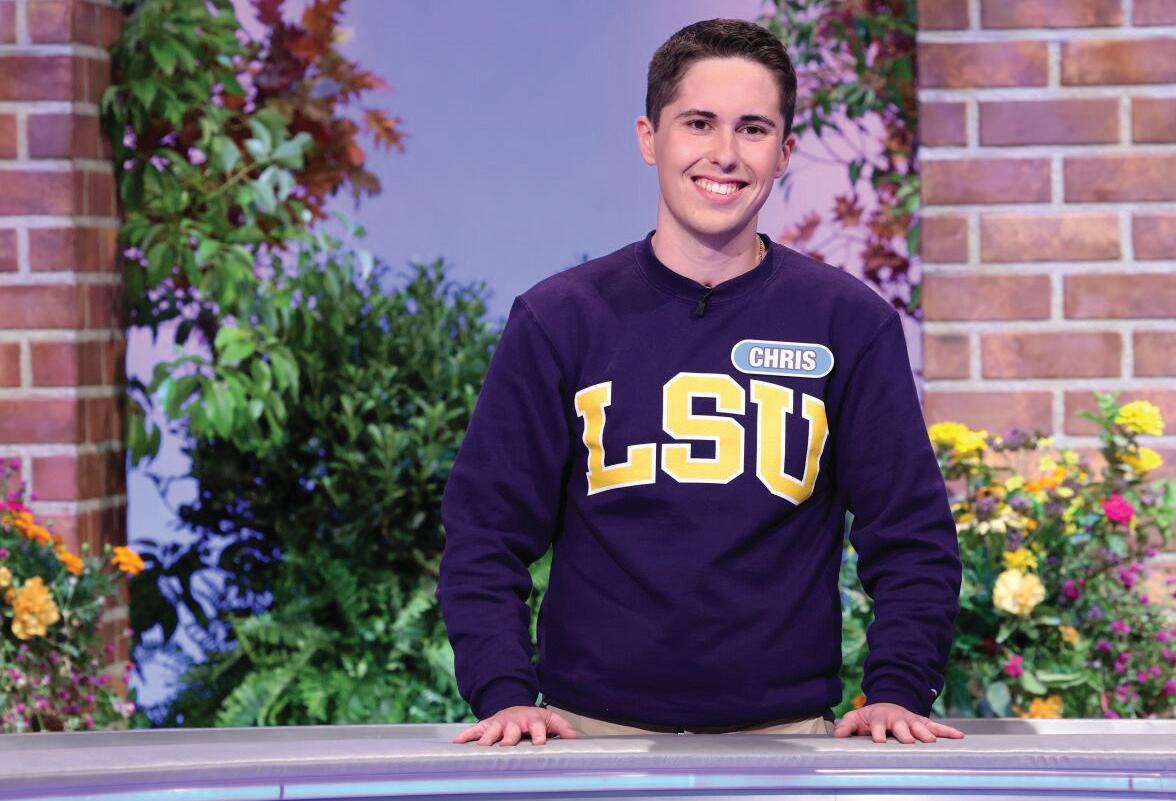 BY NYX CROOKS @voiceofnyx1
BY NYX CROOKS @voiceofnyx1
When Christopher Langley ap plied to “Wheel of Fortune,” he did so on a whim. He had no idea he would be chosen as the next contestant on the famous televi sion game show.
He had no idea he’d win $19,550 in cash and prizes either.
In May 2021, Langley, an LSU broadcast journalism senior, de cided to apply to be a “Wheel of Fortune” contestant.
“I filled out the form, sent a video of me explaining why I would be a great contestant and then submitted the application,” Langley said. “Cue December, I get an email inviting me to do a virtual audition for the show.”
The audition was part inter view, part writing test and partly a portion of the game itself.
“Once I completed everything, I was told I would hear back in two weeks if I was selected to be a contestant,” Langley said.
Two weeks later, he was cho sen.
For Langley, this was a dream come true from his childhood.
“My dad and I would always watch ‘Jeopardy!’ and ‘Wheel of Fortune’ after our family ate din ner,” Langley said. “We’d have a friendly competition to see who would do the best during each episode.”
It was Langley’s father who recommended he try out and sub mit an application to “Wheel of Fortune.”
Together, they went to Holly wood to record the show.
“It was so weird walking around the set,” Langley said. “Watching it through the TV is one thing, but being there in per son is a whole other experience.”
Langley said getting the chance to spin the wheel was fun and a memory he’ll forever hold close.
As for his winnings, Langley said he’s planning to use it for fu ture investments, like bills and a new car.
He encourages anyone inter ested in competing in a game show to apply.
“It may seem like a long shot, but anything is possible when you put your mind to it,” Langley said.



Despite inheriting a locomo tive that had fallen apart under its previous engineer, one that was losing vital pieces left and right through no fault of his own, Brian Kelly found a way to get it running and running efficiently, having it on track to reaching its destination a few years ahead of schedule.
Often times, the rides weren’t pretty. Each checkpoint posed its own set of challenges and usually, the engine faltered at the start, causing the train to trudge slowly out of the station and confuse its passengers. There were even a few cases where the train broke down before reaching its checkpoint, el evating suspicion from passengers but not warranting shutdown from inspectors.
Eventually, Kelly’s repairs paid off and with every component in the right place, the rides from checkpoint to checkpoint began to run more smoothly. Soon, the train faced two checkpoints be fore it was scheduled to reach its final destination, one seemingly
WOMEN’S BASKETBALLeasy and the other more primed for breakdown, yet still not impos sible to reach.
Train metaphors aside, LSU en tered its final regular season game ranked No. 5 in the nation with a serious chance to make the Col lege Football Playoff under firstyear Head Coach Brian Kelly. It faced a team that had recently got
ten blown out by Florida, beaten by Auburn, one of the worst teams in the conference, and struggled to put up points against a then 1-11 UMass team.
The loss that occurred in Col lege Station Saturday night, a game in which the Aggies put up their highest point total of the season and rushed for 274 yards,
sent shock waves through the col lege football world. Despair and disbelief were the primary emo tions LSU fans felt as they stared at their televisions at home, too shocked to turn it off or change the channel to something less gutwrenching. “I told you so’s” from those that criticized LSU’s ranking littered social media, though I’m sure those posting were just as surprised as the rest of us were.
You can tell yourselves time and time again that you’re satisfied with a 9-3 regular season finish and SEC West tournament bid. I mean, most preseason projections had LSU winning seven or eight games this season and that was before the Tigers lost their opener to Florida State, a game that most making projections had them win ning.
But fans of the program know that’s not what they had in mind. Even the more optimistic were un easy about the prospect of facing Georgia, the consensus No. 1 team in the nation. This team made Tennesse, who handed LSU a 4013 loss at the beginning of the season, look average at best. But that’s the thing.
LSU just completed its fall train ing to prepare for the 2023 season with a lot of expectations.
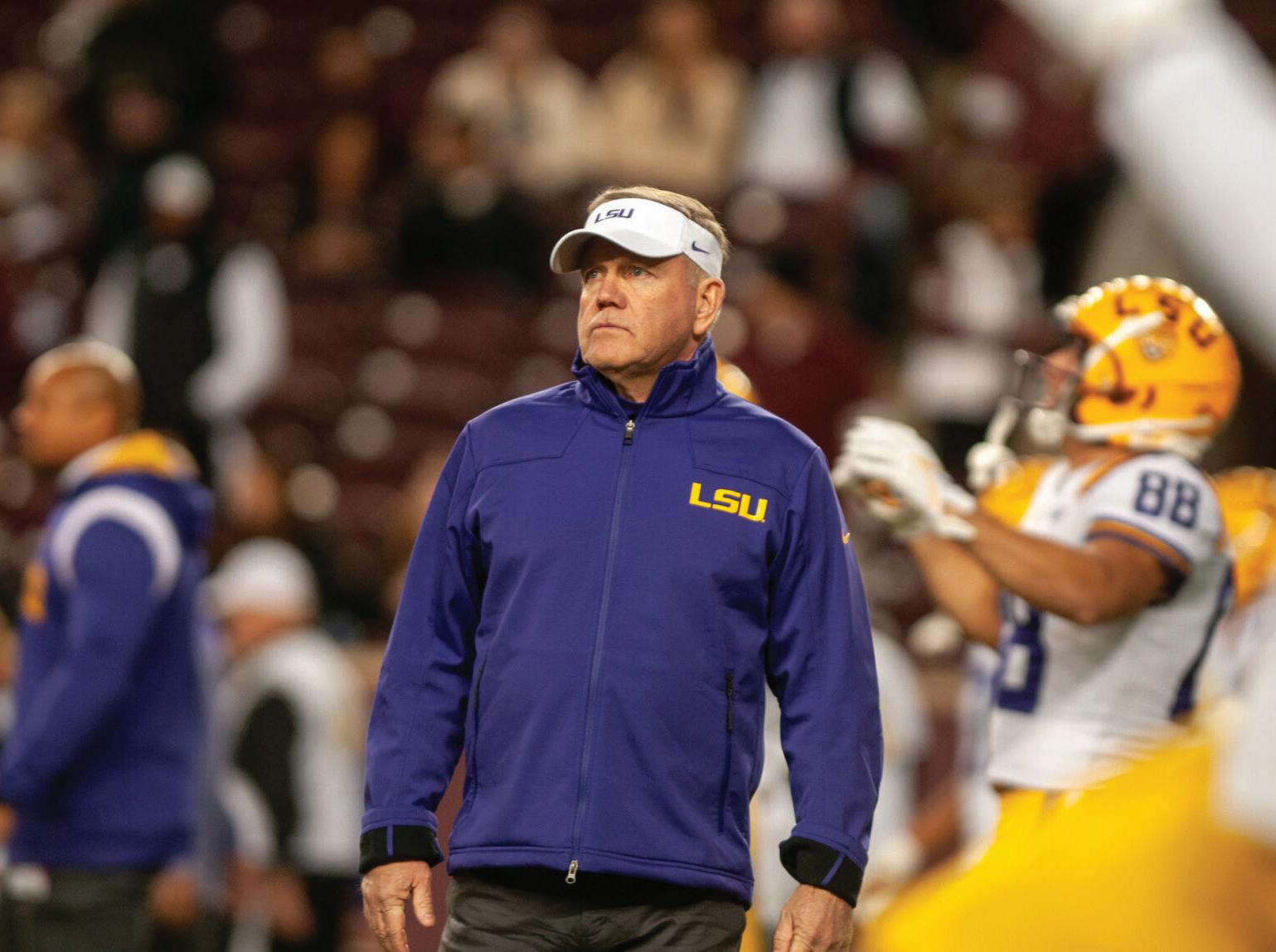
LSU Head Coach Jay Johnson will be in his second year as the skipper for the Tigers. With star players Tre Morgan and Dylan Crews returning and a slew of trans fers coming in, expectations have never been higher in Baton Rouge as LSU is looking for a chance to return to Omaha for the first time since 2017, where the Tigers lost to conference rivals Florida in the College World Series final.
However, Johnson is remind ing the team that they will have to stay focused as much as possible because it takes a team to play well together to meet their goals, not its individual talent.
“One of my biggest jobs with this generation is understanding the difference between substance and image, or hype and reality,” Johnson said. “It’s about the play.
Emily Ward, a Louisiana na tive, has been a walk on for LSU’s Women’s Basketball team for three years.
This year, she earned a schol arship to continue playing for the Tigers.
Growing up in Bossier City, Louisiana Ward has always been an athlete. She played numerous sports throughout her childhood besides basketball, including ten nis, soccer, softball and more. For Ward, however, basketball was al ways her passion.
“I liked basketball the most.” Ward said. “When I played grow ing up, I would always play with the boys. I was always on the same level as the boys, so coaches would have me playing with them in recreation and church leagues.”
Ward initially made both the soccer and basketball teams in her hometown in Bossier City but chose to focus on basketball. She was the star of Benton High School’s basketball team, averag ing 18 points and 12.5 rebounds per game, leading the Benton Ti gers to the 4A state championship game in her senior year.
The decision for after high school came as a tough choice,
with Ward receiving scholarships from other Division I schools. For Ward, her heart was always set for Baton Rouge.
“It was a tough decision, but I’ve always loved LSU,” Ward said. “I went to all the football games growing up, and I’ve always want ed to be able to have that full col lege experience. I felt LSU was the best place for me.”
Ward has been a member of the team since graduating from Benton High School in 2019, join ing the Tigers as a preferred walkon. A video posted by LSU shows her finally receiving a well-earned scholarship from Coach Kim Mulkey and being congratulated by her teammates. The story of her scholarship is much more in teresting.
“Before the video was sent out, [Coach Mulkey] told me in ad vance. One day, we were watch ing the film from a scrimmage in practice. I did something good, and she looked at me and asked, ‘Emily, are you on scholarship?’ I replied no, and then Coach went on and gave me a ton of compli ments, and then she just said, ‘I’m giving you a full scholarship for the spring semester.’ And then she just went right back to studying the film,” Ward said.
Ward was star struck when
she first learned of her scholar ship, and a very brief celebration from her teammates followed, but Mulkey continued film study as if nothing happened. Ward ex pressed her excitement, describ ing the video that she says she can’t watch.
“The video they clipped to gether only shows a little bit of the team and I celebrating, but we
were jumping up and down for over two minutes straight. At one point they knocked me down and lifted me up and just continued celebrating,” Ward said.
The celebrations continued well after the video ended, and Ward is grateful for the love she has received from everyone at LSU.
The decision to take a pre
ferred walk-on spot at LSU has considerably paid off, as Ward has felt at home in Baton Rouge. She expressed her love for her team mates and coaches at LSU and their constant support.
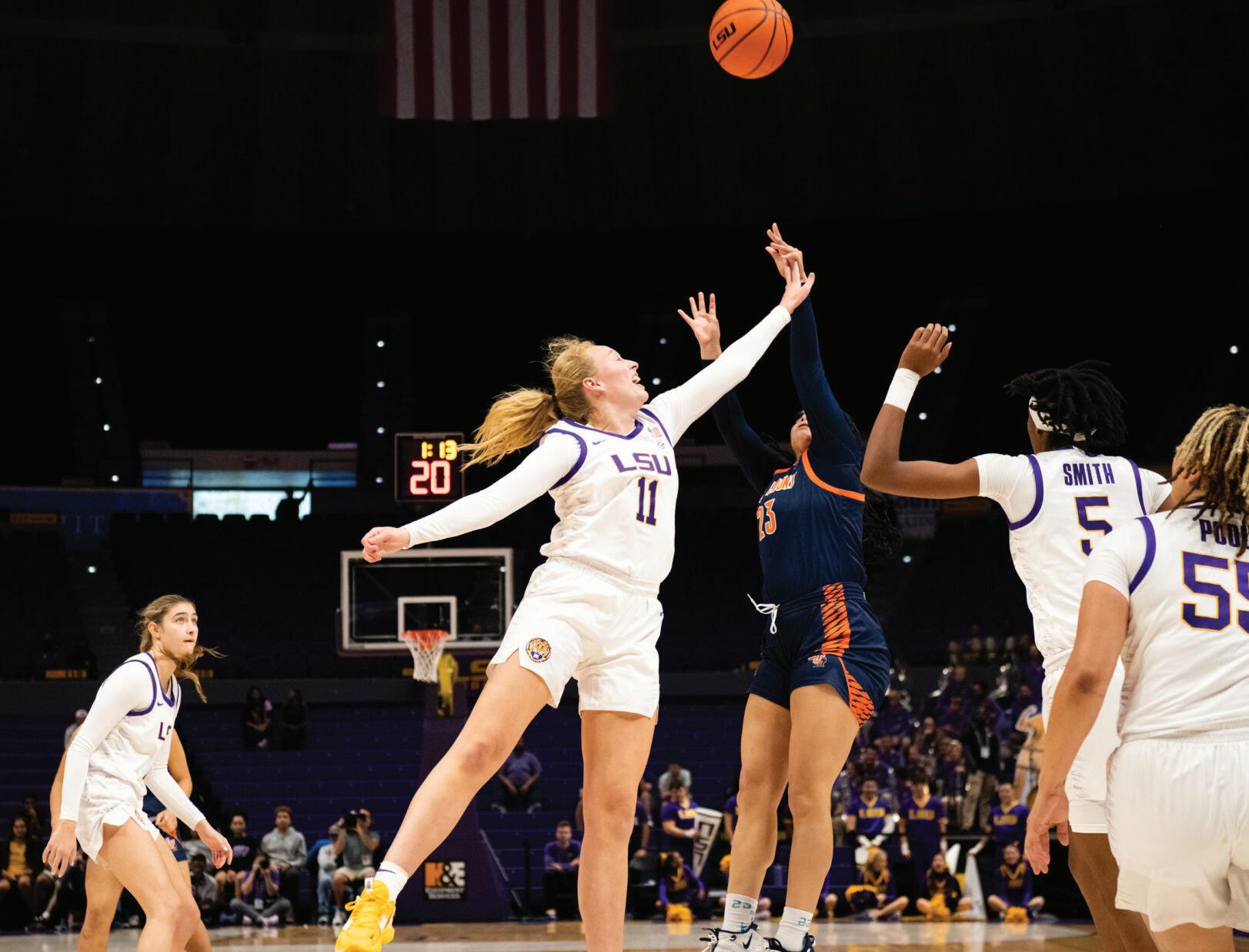
“I feel very loved here, and we’ve all already meshed so well together. We’re only four games into the season and we’re already so close,” Ward said.
With the Tigers having one of the best beginnings to their sea son in NCAA history, the future looks bright for Mulkey’s team. Currently undefeated after four games and boasting wins by over 60 points, Ward and the Tigers look to cement their spot amongst the top colleges this season.
“For the team, we want to im prove on where we ended last year and go farther in the NCAA tour nament.” Ward said. “Personally, I want to take it all in. Coach Mulkey says these are the best years of our lives, so I want to enjoy it while it lasts. I’m excited about the future, but I want to enjoy the present.”
Ward is excited for her senior season but is also extremely grate ful for the time she has spent at LSU thus far. Showing her undeni able humility and great character, Ward extended a thank you to her parents for all of her success, and she looks to continue it this year.
TO A&M, from page 9
They were supposed to get their answer there.
Most conversations across the state of Louisiana regarding the matchup against Texas A&M fea tured an attitude of cautious op timism, with fans feeling unsure about the prospect of facing a ri val filled with talent but reassured that its record was 4-7 on the sea son.
But reality strikes hard and the fact of the matter is, this game held the recipe for disaster. An op ponent filled with five-star talent that had come inches away from
EXPECTATIONS, from page 9
Baseball is a unique sport, where it’s not the team with the best play ers; it’s the team that plays the best that day.”
With that being said, here are some of the things that happened during the fall and how that could translate in the spring.
The pitching staff has gotten stronger and gained depth
After having problems with depth last season, LSU’s pitching staff is at its strongest since 2017, the last time they went to the Col lege World Series in Omaha. LSU returns starter Ty Floyd and relief pitchers Sam Dutton, Riley Coo per, Grant Taylor and Bryce Col lins. The Tigers also return Blake Money and Javen Coleman in the pitching rotation as well.
The one thing that affected LSU last year was that the Tigers did not have a true starting lineup, and it was evident against Southern Miss in last year’s Hattiesburg regional in the NCAA Tournament. Howev er, Johnson hit the transfer portal hard.

Johnson brought in pitchers Paul Skenes, Thatcher Hurd and Christian Little through the trans fer portal.
Skenes, the 2022 Mountain West
defeating Alabama and had one last chance to accomplish some thing big to conclude a miserable season was facing an imperfect team with everything to lose in its own stadium. It doesn’t matter that it took 11 games for the Ag gies to figure things out.
“We ran into a team that played really well tonight at home and we just didn’t have what it took to night, for whatever reason,” Kelly said after the game. “We’ll learn from this.”
A train on track to the Col lege Football Playoff ran out of fuel and broke down for the third time, giving inspectors enough ev
Pitcher of the Year and 2021 Moun tain West Freshman of the Year, is an All-American caliber pitcher who was used as an utility player due to his batting prowess while he was at the Air Force Academy. Skenes had a 10-3 win-loss record and a 2.73 ERA.
Hurd transferred in from UCLA, which has been one of the best col lege baseball programs in the last decade and has developed many current MLB players such as Gerrit Cole and Brandon Crawford. Hurd made nine appearances, includ ing six starts, as a true freshman.
Hurd had a 2-0 record, 1.06 ERA, and a .138 batting average over 34 innings while pitching for the Bru ins.
Little, who transferred to LSU after being at Vanderbilt for the last two seasons, is one of the most promising pitchers in the SEC. He will be a key piece as a relief pitch er for LSU this upcoming season.
True freshman right-handed pitcher Chase Shores and left-hand ed pitcher Griffin Herring could see some action as well.
LSU star first baseman Tre Mor gan was very complimentary of his new teammate Skenes as well as Taylor, who Morgan said was giving him quite the bit of trou ble when ever Taylor was on the
idence to finally shut it down for good. But considering how far it traveled with components it had, it should still be commended for its resilience.
“This was one of the most en joyable years that I’ve had in my career in watching these kids grow. This was not a step back,” Kelly said. “I don’t want this loss to at all take away from what they’ve accomplished this year.”
LSU’s wins against Mississippi State, Auburn and Ole Miss all fea tured double-digit deficits in the first half. Its best player was in jured for the year on its eighth de fensive play of the season and its
mound.
“Skenes is ridiculous. Going up there, he’s got that 99 mile per hour fastball and 70 mile per hour curveball. It’s crazy,” Morgan said. “But Grant Taylor with it on his mind this year. He looks way dif ferent. You can just see the chang es that he’s made to his body. You feel it in the box — that fastball feels really heavy. He’s the only pitcher this fall that I didn’t get a hit off of.”
The 2022 freshman class looks promising
LSU is bringing in the No.1 re cruiting class in the country and some of them look like they can play right away.
Outfielder Paxton Kling, who was the No. 14 overall prospect in the class of 2022, has been impres sive all fall. Kling has hit six home runs and recorded 15 runs batted in, while batting an average of .269. He also had the second most extra base hits on the team with 11 during fall ball. He started all four of LSU’s exhibition games against McNeese and Louisiana-Lafayette.
Gavin Guidry also performed well. Guidry, the No.1 player from the state of Louisiana, recorded two home runs, 10 RBIs and a bat ting average of .259. He started all four exhibition games as well.
communicative leader on defense was knocked out for four games with a neck injury.
It entered its toughest stretch of the season already sporting one loss, lost its first game of said stretch by 27 points, then pro ceeded to win four straight games against SEC opponents, including Ole Miss and Alabama. The fact that the Tigers were in the posi tion they were in heading into their last game of the regular sea son was extraordinary, and it’s the reason the loss to Texas A&M was so excruciating.
A fanbase that had suffered through the last two seasons, only
Another freshman who per formed really well this fall was out fielder Zeb Ruddell. Although he might not play for a good bit of the season due to the depth of LSU’s outfield, Ruddell’s play this fall will definitely give LSU fans a glimpse of what the future can be. Ruddell had a batting average of .264 along with five home runs and 13 RBIs.
Pitcher Chase Shores will get plenty of experience as a true freshman. Shores, who was the No.1 right-handed pitcher from the state of Texas, recorded a 2.12 earned run average, which was the second best on the team this fall.
“Chase Shores is the most-ready to make a significant impact. We were very fortunate that we were able to get him from the MLB base ball draft, and the talent is easy to see, but the poise and mound presence and confidence is very advanced for a player of that age,” Johnson said.
Left-handed pitcher Griffin Her ring will see some time this season as well. Although he went through some growing pains during the fall, Johnson was very complimen tary of Herring and expects big things from him in the future.
“We think Griffin Herring is go ing to be a really good left-hander. We’re trying to add more and his
having its 2019 season to fall back on for comfort, was back on the top of the world. The rest of the college football world complained but that was just another sign that LSU was back.
The feel-good story may be over but that doesn’t mean that that last statement doesn’t ring true in the minds and hearts of Ti ger fans everywhere. LSU is back. Kelly may lose some of the com ponents that allowed it to get this far after this season, but a whole array of new ones is scheduled to come in very soon.
Not to mention that there are still two games left in the season.
fastball is up to 93, kind of surpris ingly, and has a really good break ing ball.”
Skenes was everything that Ti ger fans had hoped for this fall. Skenes had an earned run average of 3.45 and struck out 26 batters while hitting five home runs and nine RBIs with a batting average of .216.
Third baseman Tommy White also had an excellent fall. White, who was named a Freshman AllAmerican last season for North Carolina State, hit seven home runs and 15 extra base hits. White also recorded 15 RBIs and a batting av erage of .354.
Although he was a designated hitter for North Carolina State last season, White will play in the in field at third base for the Tigers. However, White isn’t uncomfort able playing in the infield.
“I’ve played third base my en tire life, so it was kind of hard to not play last year at NC State,” White said. “I just needed that con fidence boost back. I’ve been over there [at third] every single day in the fall. It’s just as comfortable as it was in high school, so I have con fidence back over there and am re ally excited.”
Despite my criticism of the university at times, the campus shaded by these stately oaks and broad magnolias is a spe cial place, and, as students, we’re lucky to spend some of our most formative years here.
When I started my time as a student at the flagship, I couldn’t have imagined all of what would happen over the next three-anda-half years, but I couldn’t be more elated at how those experi ences molded me into the person who will be walking across the graduation stage in a couple of short weeks.
I’ll remember everything from the highs of a national champion ship victory in our own backyard to the lows of dominating na tional headlines after USA Today released a gut-punching exposé on the university’s adjudication of sexual misconduct allegations.
A line in the LSU alma mater reads, “Fond memories that wak en in our hearts a tender glow,” highlighting the cherished memo
ries of generations of Tigers do ing the little things on campus that make it special—from study ing in the library late into the night, walking in the Enchanted Forest or having a picnic on the Parade Ground.

Making the most out of these small moments with friends is my ideal way to plug away through college with enjoyment.
From the small moments to the big moments, your friends and fellow Tigers will always be there when you need a little bit more encouragement on a lastminute paper, help on a math problem or just had a rough hour in Himes Hall.
It’s a promise made to us by the alma mater, which says, “And make us happy for the love that we have learned to know.”
While I’ve loved my experi ence here at the flagship, my pas sion for the university drove my pursuit to highlight its shortcom ings through my work in Student Government and at The Reveille, hoping it would make us a stron ger institution in the long run.
I’m excited for what the fu ture holds for LSU given favor able state budgets the last several years and a new strategic plan be
ing developed to implement LSU President William Tate IV’s Schol arship First Agenda.
I hope when I return to these inspiring halls as an alumnus watching Alabama lose in Tiger Stadium that I can also say that
LSU realized its potential to bet ter serve and elevate the state and people of Louisiana.
Knowing that anywhere I end up in life, I’ll always be able to yell “Geaux Tigers” and instantly make new friends is a special
thing. I will always Love Purple and Live Gold.
LSU sent out an email in Janu ary 2022 in partnership with Cae sars, a gambling company. That email read, “bet $20, get $300” and encouraged students to use the LSU code to access this offer.
This email was sent to some underage students, which the university later said was by mis take, according to The New York Times.
College has long been viewed as a virtuous journey that is made by those who want better lives for themselves and their families.
This partnership and email ad fly directly in the face of that.
Think of it through the lens of the university’s vision and mission statement. The vision of the university is to “achieve the highest levels of intellectual and personal development,” and its mission is “the generation, pres ervation, dissemination, and ap
plication of knowledge and cul tivation of the arts,” according to LSU’s website.
If I were to think of an activ ity antithetical to intellectual and personal development, it would be gambling. Gambling doesn’t preserve nor disseminate knowl edge. Much like drinking or drugs, gambling is simply a vice that, if left unchecked, becomes an addiction that is a barrier to a good life.
One might say, OK, so the university used its email to push a vice upon its students, and that’s kind of bad, but did it vio late its own policies in doing so?
According to LSU’s email pol icy statement, LSU email is only to be used “to facilitate the Uni versity’s mission.” From my read ing of this, an email encouraging gambling doesn’t facilitate LSU’s stated mission.
Not only that, but according to the Responsible Marketing Code, marketing guidelines cre ated by the American Gaming Association, “Sports wagering should not be promoted or ad
vertised on college or university campuses.”
We expect to see advertise ments all around us. Advertising is one of the biggest industries in the world. According to Statista, the United States spent more than $285 billion dollars on advertis ing in 2021. The vast majority of these advertisements are digital. You’ll most likely see many ads today when scrolling through Facebook, TikTok, Twitter or the Wall Street Journal when reading up on the latest news.
You might even get spam emails advertising certain prod ucts to you. How they got your email? Who knows.
We do know, however, how the university got your email. LSU created your email for you because you paid them thou sands of dollars and decided to go to the university to increase your marketability as a worker and to expand your chances for success in the world.
We, as students, view the uni versity as a source of knowledge and an intellectual guidepost.
Americans, in general, view col lege as the next logical step after high school in bettering oneself and enhancing the probability that one is successful in life.
When the university engages in behavior that doesn’t align with its stated mission, our perception of the university is frayed. The university risks stu dents and professors questioning the validity of its mission.
“It just feels gross and tacky for a university to be encourag ing people to engage in behavior that is addictive and very harm ful,” said LSU political communi cation professor Robert Mann in an interview with The New York Times.
This is precisely correct.
Colleges and universities take up the noble task of educating the next generation; in this, they assume a position of authority over its students.
A question worthy of ask ing in this situation is what duty does the university have to its students in this position of au thority? It can be described as
a “duty to care,” said Deborah Goldgaber, director of the LSU Ethics Institute.
LSU, as a university, claims to be in a position of moral au thority that comes from its stated mission. When it violates its duty to care, it slowly picks away at that position.
“The duty of care may have been violated by encouraging gambling,” Goldgaber said.
The university administra tion should explain why it thinks a partnership with a gambling company is worth the reputa tional damage it might cause—or perhaps has already caused.
LSU can’t claim moral author ity, violate the tenants of that au thority and offer no explanation for why it believes its actions were acceptable.
Put simply by Goldgaber, “The person responsible for this decision should justify their ac tions.”
Brandon Poulter is a 27-year-old political science and psychology major from Baton Rouge.


The Reveille (USPS 145-800) is written, edited and produced solely by students of Louisiana State University. The Reveille is an independent entity of the Office of Student Media within the Manship School of Mass Commu nication. Signed opinions are those of the author and do not necessarily represent the views of the editor, The Reveille or the university. Letters submitted for publication should be sent via e-mail to editor@lsu.edu or deliv ered to B-39 Hodges Hall. They must be 400 words or less. Letters must provide a contact phone number for ver ification purposes, which will not be printed. The Reveille reserves the right to edit letters and guest columns for space consideration while preserving the original intent. The Reveille also reserves the right to reject any letter without notification of the author. Writers must include their full names and phone numbers. The Reveille’s edi tor in chief, hired every semester by the LSU Student Media Board, has final authority on all editorial decisions.
George Bush“I know the human being and fish can coexist peacefully.”
W.
former U.S. president 1946 — presentCharlie Stephens is a 22-year-old political communication senior from Baton Rouge. KARLI SMITH / The Reveille Mike the Tiger struts towards the glass on Oct. 18 at Mike the Tiger’s Habitat in Baton Rouge, La.
As I walk between classes or to Barnes and Noble, I no tice all of the people crossing streets and all of the cars driving around. Although I have music in my ears, I stay aware of my surroundings, especially on the crosswalks or near streets.
Pedestrian safety is a big fo cus in many cities. According to a July 2022 report from an urban policy group, Baton Rouge is the 11th deadliest U.S. metro for pe destrians.
Since September, there have been three pedestrian-involved accidents in Baton Rouge, two of which took place near cam pus and one of which led to the death of the pedestrian, ac cording to reporting by WBRZ, WAFB and BRPROUD.
After speaking with Bart Thompson, chief of the LSU Po lice Department, I’ve realized the university does a lot to keep pe destrians safe, and while there’s always room for improvement, a lot of issues lay in the hands of pedestrians and motorists.
“There’s always more (that can be done), but it’s a two-way street. It’s the fact that our stu dents and our faculty and staff also need to understand that pedestrians are involved in our traffic,” Thompson said.

Thompson said some pedes
trians enter crosswalks without yielding, but they should pause “to make sure that the vehicle is abiding by and sees you in that crosswalk.”
Another issue is motorists not paying attention, he said. An example he gave was when there’s a green light, but the car is turning right, there would also be a pedestrian walk signal, so the car should be yielding.
LSUPD alone can’t control all of these factors, so while it does its part, pedestrians need to do their part.
One big part of pedestrian safety is education. Thompson says that LSUPD educates stu dents during every orientation about pedestrian and campus safety.
“Anytime we are able to meet with a group about safety, pe destrian safety is one of the piec es,” he said.
The university addressed the issue of dark areas on campus by putting up 25 temporary light trailers around commuter park ing and on the main campus, Thompson said. This improve ment is especially beneficial to pedestrians who may not be seen in these darker areas and are therefore in greater danger of being hit.
He adds that one thing the university could improve upon is ensuring that, during road work, crosswalks are lined and there are handicap ramps.
Education on pedestrian and bike safety can also be found
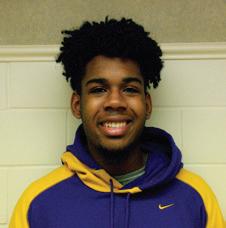
on the LSUPD website. Along with education, LSUPD has cam paigns to influence pedestrians.
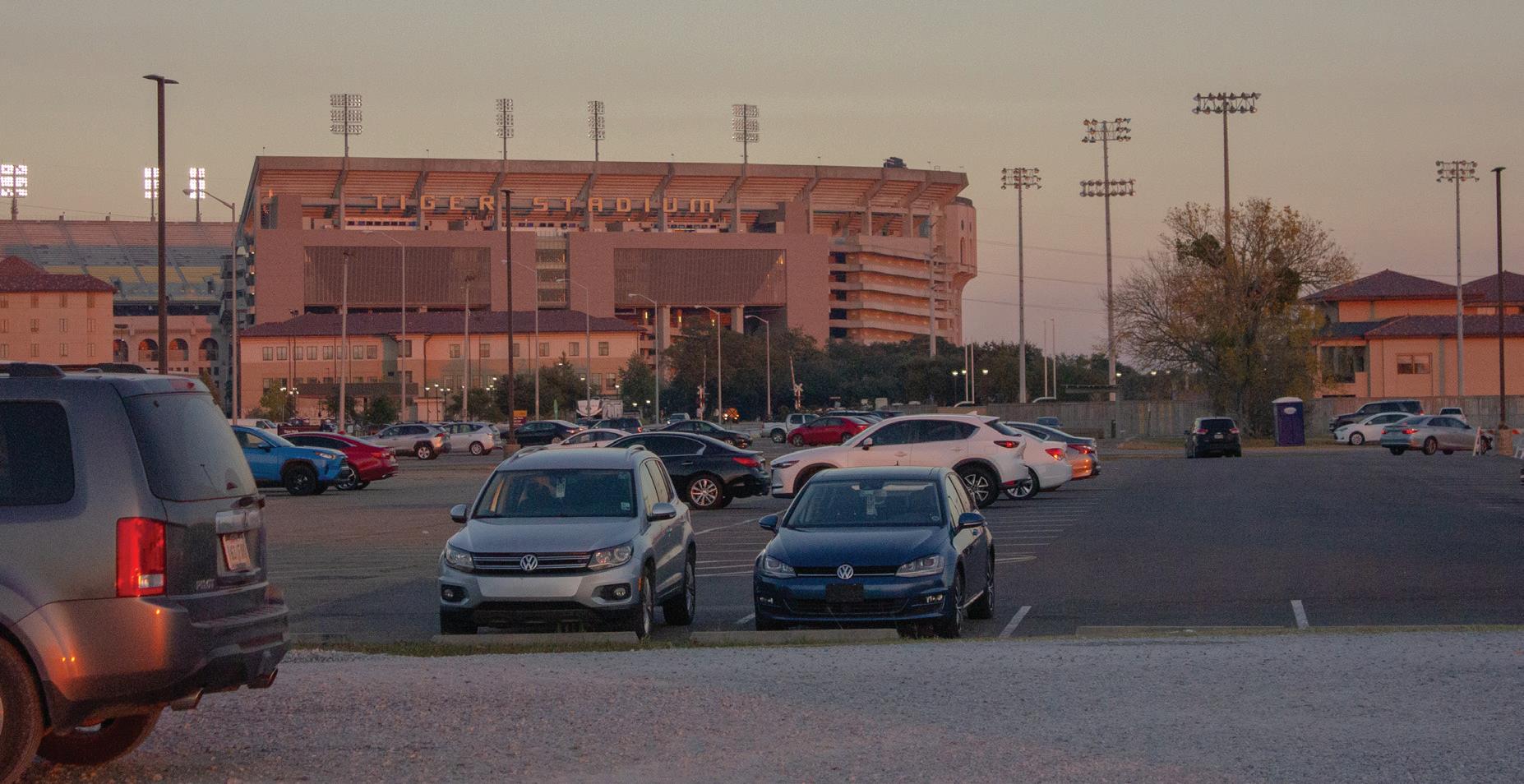
Thompson said in 2013 the LSUPD began a “zombie cam paign” focused on the recent release of the movie World War Z and comparing pedestrians glued to their phones to “zom bies.” According to contempo rary reporting by The Reveille, the campaign began after a few pedestrian accidents on campus.
“Don’t be a zombie, pay at tention to where you are and where you’re walking,” the cam paign said, according to Thomp son.
As someone on campus near ly every day, I’ve seen firsthand the issue of pedestrians and drivers being focused on their phones instead of the road. I’ve also heard multiple peers bring up the topic of everyone on cam pus staring at their phones at all times.
Seeing as it’s such a promi nent issue, noticed by faculty, staff and students, it’s time for pedestrians and drivers to take more accountability.
Drivers shouldn’t be on their phones, especially in areas with pedestrian crossings. Nothing is more important than people’s lives, so just wait to check your
phone until you’re parked.
Pedestrians also need to pay attention when walking near streets and crosswalks. While most have music play ing, it shouldn’t be so loud that you can’t hear what is going on around you.
With accountability from pe destrians and drivers, many of the issues causing accidents can be solved.
Pay attention to your sur roundings, and stay off your phone. Those simple tenants will keep you and others safe.
Former President Donald Trump announced his 2024 bid for president on Nov. 15, giv ing a tedious, hour-long speech that left much to be desired.

Anyone watching the speech can tell he’s lost his fastball. He doesn’t look like the guy who delivered so many viral video clips just a few years ago. To fix this issue, he must get back to the core of his political philoso phy: trolling.
Trump’s political career is based on undermining the po litical system. He was an out sider that could poke fun at the self-serious liars next to him. It’s possible that four years of governing based on The Heri tage Foundation playbook molded him into a more boring, straight-edge politician.
His official statement bash ing Republican establishment darling Florida Gov. Ron De santis by calling him Ron “De sanctimonious” was a step in the right direction, but it also shows the gap between what he was and his current state.
“Desanctimonius” isn’t the best nickname. He’s trying to
be too clever. It’s a bit long, and most of his supporters prob ably had to Google the mean ing of the word sanctimonious to get it. In his prime, he had names that stuck; they were simple and descriptive. “Low Energy Jeb,” “Little Marco” and “Crooked Hillary” weren’t the most clever names in the world, but that was a part of the ap peal.
The ability to troll is much like a muscle in that it will de teriorate if not used. The good news for Trump’s 2024 cam paign is that he can get back into form by honing his skills on Twitter.
He’d be smart to do it soon, as Elon Musk is doing his best to speed run the demise of Twitter.
Trump could use Twitter to directly criticize President Joe Biden’s tweets. Trump could simply quote retweet a Biden tweet with the word “ratio,” and he’d probably break the record for most likes on a tweet in a day.
He could also focus on de stroying his weaker primary opponents by simply calling them losers. These small easy victories would be perfect for the former president to get his mojo back.
Critics say that Trump
shouldn’t be allowed back be cause of his role in the Jan. 6 insurrection, however, that was nearly two years ago. Ultimate ly, does it matter who incited whom to storm the capitol in an attempt to overthrow an elec tion? Such minor details will be lost to history.
Now armed with the knowl edge that inciting a coup d’état is bad, Trump should use Twit ter to mobilize his supporters toward a better and more legal goal: winning the culture war.
One major battle conserva tives are fighting is against Star bucks baristas for having dyed hair and septum piercings. Trump could instruct his sup porters to take over Starbucks stores and force them to draw pictures of bald eagles and of him and Ronald Reagan shak ing hands.
Another battle conservatives had was against football players who kneeled for the national anthem. Nobody is kneeling in the NFL or even college for that matter, but maybe Trump could lead a harassment campaign against a high schooler for do ing it.
A more recent battle took place over the recasting of white movie characters as peo ple of color. Trump could get his supporters to storm every
movie theater in America and demand that they color-correct the film to make all of the char acters white.
Trump is on the back nine of his political career. If he keeps up like this, his best days as a politician—and, more impor
tantly, a troll—are behind him. The only way for him to find what he’s lost is by coming back to Twitter.